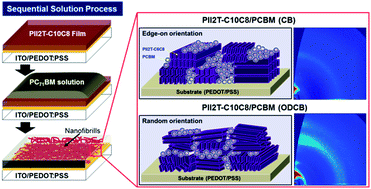Sequentially solution-processed, nanostructured polymer photovoltaics using selective solvents†
Abstract
We demonstrate high-performance sequentially solution-processed organic photovoltaics (OPVs) with a power conversion efficiency (PCE) of 5% for blend films using a donor polymer based on the isoindigo-bithiophene repeat unit (PII2T-C10C8) and a fullerene derivative [6,6]-phenyl-C[71]-butyric acid methyl ester (PC71BM). This has been accomplished by systematically controlling the swelling and intermixing processes of the layer with various processing solvents during deposition of the fullerene. We find that among the solvents used for fullerene deposition that primarily swell but do not re-dissolve the polymer underlayer, there were significant microstructural differences between chloro and o-dichlorobenzene solvents (CB and ODCB, respectively). Specifically, we show that the polymer crystallite orientation distribution in films where ODCB was used to cast the fullerene is broad. This indicates that out-of-plane charge transport through a tortuous transport network is relatively efficient due to a large density of inter-grain connections. In contrast, using CB results in primarily edge-on oriented polymer crystallites, which leads to diminished out-of-plane charge transport. We correlate these microstructural differences with photocurrent measurements, which clearly show that casting the fullerene out of ODCB leads to significantly enhanced power conversion efficiencies. Thus, we believe that tuning the processing solvents used to cast the electron acceptor in sequentially-processed devices is a viable way to controllably tune the blend film microstructure.


 Please wait while we load your content...
Please wait while we load your content...